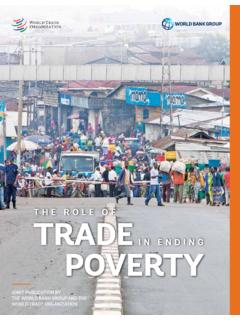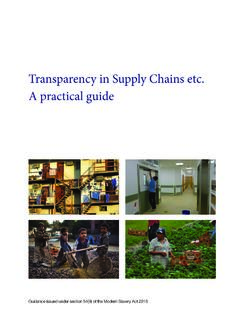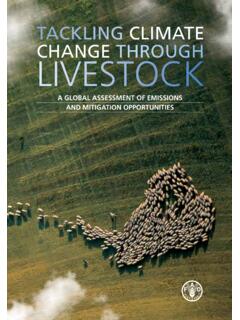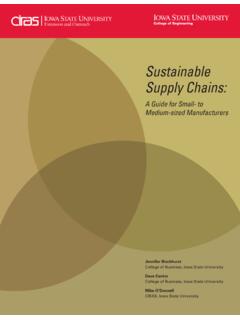Transcription of Understanding Supply Chain 4.0 and its ... - Global trade
1 103 CHAPTER5 Understanding Supply Chain and its potential impact on Global value chainsMichael J. Ferrantino (World Bank Group) and Emine Elcin Koten (World Bank Group)*ABSTRACTThe reorganization of Supply chains using advanced technol-ogies, such as the Internet of Things (IoT), big data analytics, and autonomous robotics, is transforming the model of Supply Chain management from a linear one, in which instructions flow from supplier to producer to distributor to consumer, and back, to a more integrated model in which information flows in an omnidirectional manner to the Supply Chain . While e-commerce is uniquely suited to many of these techniques, they also hold the promise of improving efficiency in brick-and-mortar stores. These technologies are generating enor-mous benefits through reducing costs, making production more responsive to consumer demand, boosting employment (employment in Supply Chain sectors where such technologies are most likely to be applied has grown much more rapidly than in other Supply Chain sectors and in the economy as a whole) and saving consumers time.
2 The impact of these tech-nologies on the length of Supply chains is uncertain: they may reduce the length of Supply chains by encouraging the reshor-ing of manufacturing production to high-income economies, thus reducing opportunities for developing countries to par-ticipate in GVCs, or they may strengthen GVCs by reducing coordination and matching costs. Digital technologies are transforming Supply Chain management from a linear model in which instructions flow from supplier to producer to distributor to consumer, and back, to a more integrated model in which information flows in multiple directions (sometimes referred to as Supply Chain ). Digital technologies offer huge benefits in terms of inclusive patterns of growth, innovation and entrepreneurial opportunities The impact of new digital technologies on GVCs is uncertain: they may reduce the length of Supply chains by encouraging the reshoring of manufacturing production, thus reducing opportunities for developing countries to participate in GVCs, or they may strengthen GVCs by reducing coordination and matching costs.
3 * We are grateful for helpful comments by Gary Hufbauer, Satoshi Inomata, Kalina Manova, William Shaw, Emmanuelle Ganne, and Lauren Deason. All errors and omissions remain the responsibility of the Technological innovation, Supply Chain trade , and workers in a globalized world1. Introduction Supply Chain is the re-organization of Supply chains design and planning, production, dis-tribution, consumption, and reverse logistics using technologies that are known as Industry . These technologies, which emerged in the 21st century, are largely implemented by firms that are at the frontier of Supply Chain management in high-income countries. Though, as we will argue, this classification is somewhat artificial, it does in fact capture certain prevailing ideas about what firms need to do, and are doing, in order to maintain competitive Supply Supply Chain is here alreadyWhile much of the literature we will review is forward-looking, and indeed has emerged only in the last two or three years, almost all of the technologies we discuss are being imple-mented today, at least by firms at the frontier of Supply Chain management, which by and large are in high-income With only one or two exceptions, everything described in this chapter is already being applied in actual Supply chains, or is at least being piloted.
4 While the literature includes many ideas for emergent technologies that might be available by 2030 (for example, vast fleets of self-driving delivery vehicles, or the smart mirror in the local clothing store that supposedly will allow you to virtually try on clothes just by scanning their bar codes), this argument does not depend on the deployment of technologies that do not really exist yet. The diffusion of already existing Supply Chain technologies will already have a substantial we say that Supply Chain is here, we mean that it is here at the frontier of Supply applications and being more widely adopted, not that it is universal. Even in high-income countries, the principles of Supply Chain are unequally applied. Advanced Supply management techniques are more likely to be observed in sectors such as electronics where earlier waves of management techniques took hold first, or in big-box retailers such as Walmart.
5 As recently as February 2018, Supply Chain problems caused two-thirds of the 900 Kentucky Fried Chicken restaurants in the United Kingdom to close because they had run out of US employment by sector, Supply Chain sectors, manufacturing, transportation, post office and other, percent change (2011-2016) -5051015202530354045 Wholesale Electronic Markets, Merchandise StoresMiscellaneous Store RetailersNonstore RetailersCouriers and MessengersWarehousing and StorageSpecialty store retailersMerchant wholesalersGeneral TransportationPostal ServiceManufacturingTotal Supply Chain sectorsTotal US economySupply-chainsectorsAggregatesS Understanding Supply Chain and its potential impact on Global value chains It transforms business models, making Supply more customer-drivenWhile Supply Chain involves the deployment of such contem-porary tools as the Internet of Things (IoT), big data analytics, autonomous robotics, and the like, it is not really about any of these things.
6 It is about transforming the model of Supply Chain management from a linear model in which instructions flow from supplier to producer to distributor to consumer, and back, to a more integrated model in which information flows in an omnidi-rectional manner to the Supply Chain . While lead firms are increas-ingly analyzing this information through Supply Chain control towers, the end effect of this development could be making the goods economy more responsive to consumer E-Commerce is ideally, but not uniquely, suited for Supply Chain ability to capture data in e-commerce empowers many of the data-driven methods we will discuss. In particular, older technologies (electronic data interchange) were already gather-ing large amounts of information in business-to-business (B2B) e-commerce, which can be used to improve Supply Chain perfor-mance.
7 At the same time, most of the developments discussed here can be used to improve the performance of traditional brick-and-mortar stores, where the large majority of retailing still takes place, as well as in an e-commerce setting. It generates jobs, which substitute for household labor and promote human well beingIn an exercise using data gathered in the Occupational Employment Statistics of the Bureau of Labor Statistics, this study shows that employment in the most dynamic parts of the Supply Chain has grown at a rate substantially exceeding that of the overall economy since 2011. These sectors include warehousing and storage (used by all retailers, Walmart as well as Amazon), couriers and messengers (the sector including UPS and Federal Express, commonly known as express carriers ), and non-store retailers (particularly electronic shopping and mail-order houses, the sector inhabited by Amazon and eBay) (see Figure ).
8 Most of the jobs being created involve moving goods around either in warehouses or delivery vehicles and have many of the character-istics of factory work. Though robots are used in many of these applications, they appear, at present, to be complementary with human labor. Most importantly, e-commerce, powered by Supply Chain , involves a great substitution of market labor for household shop-ping time. Traditional shopping is a time-consuming and, for many, tedious activity. Because household time is an intrinsically scarce resource, Supply Chain is already having profound impacts on human well-being. However, time saved as a result of e-commerce also has increased employment in the transpor-tation and material moving occupations. As shown in Figure , men account for 42 percent of the time spent shopping, while women account for 58 percent, whereas men account 82 per-cent of employees in transportation and warehousing jobs, while women account for 18 percent.
9 As discussed further in section vi below, these workers, concentrated primarily in warehouses and express delivery companies, are paid to do the picking, packing, and driving that would otherwise be done by household shop-pers in the absence of It can transform the operation of Global value chainsWhether conceived of as an advanced management practice, or simply as a cluster of technologies to be deployed by advanced management practices, Supply Chain provides substantial opportunities for firms to enhance productivity, profitability, product quality, and performance in international trade . Because Supply Chain diffuses at an unequal rate, it can also influence the size distribution of firms within industries as well as income distribution across countries. The enhanced ability to track both physical and financial information also has implications for activ-ities of government which depend on highly disaggregated firm data, such as tax enforcement and monitoring of rules of origin in international The impact of Supply Chain on Technologies and management strategiesOne way to approach Supply Chain is to treat it as simply the application of Industry to the Supply And a common way to approach Industry is to treat it as simply a bundle of technologies that have emerged, or are emerging, in the 21st century (see Figure ).
10 Then the task might be simply to map the technologies in Industry to each of the steps of FIGURE Shopping and e-commerce occupations, gender division (2017)MenWomenPercentages020406080100 Time spent purchasing goods and servicesTransportation and materialmoving occupations,employmentSource: BLS American Time Use Survey, BLS Current Population Survey, and authors Technological innovation, Supply Chain trade , and workers in a globalized worldthe Supply Chain design and planning, production, distribution, and consumption. While each of the industrial revolutions is generally char-acterized by a cluster of typical technologies, the list of these technologies varies from one author to another. Cirera et al. (2017) identify 17 technologies that are said to characterize Industry (see Figure ), which are referenced two or more times in a corpus of underlying sources, of which the most fre-quently mentioned are the IoT; big data analytics; 3D printing; advanced (autonomous) robotics; sensor-using smart factories6; augmented reality7; artificial intelligence8; and cloud computing9.

















